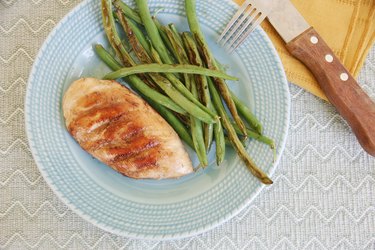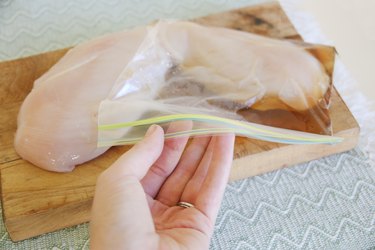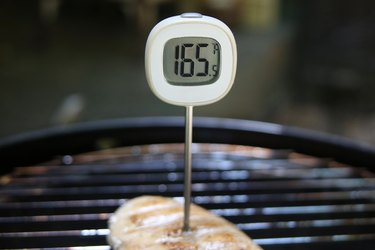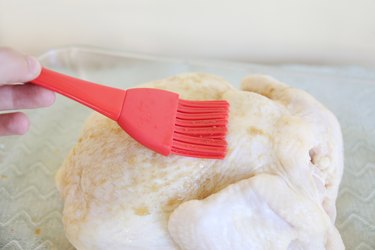
During grilling season, chicken sometimes takes on a supporting role to more show-stopping meats such as steaks or chops. However, with the right treatment, a simple selection of chicken thighs, legs and breasts can be elevated from dependable to remarkable. The key is to approach the heat with shaman-like awareness, using the correct grill set-up to achieve the required internal temperature.
Rack Prep
Video of the Day

However obvious it may seem, chicken too often goes onto a tepid grill rack that hasn't been properly prepared for the task, resulting in burned flesh, flare ups and sticking. Before the coals are lit, clean the grill thoroughly with a wire brush to remove debris, and then dip a paper towel in vegetable, canola or olive oil and wipe it over the rack. The oil will form a protective shield between heat and meat. Once the chicken is on the grill, it shouldn't be turned as long as it's sticking to the grill. It will pull away once it's ready. Chicken cooks best on a hot grill with an indirect heat. The overall grill temperature should be about 300 degrees Fahrenheit. If using charcoal, bank the coals on one side only. Alternatively, set the burners to medium-high on one side and low on the other if cooking with gas.
Video of the Day
Unbeatable Brine

Chicken breasts, in particular, are vulnerable to drying out on the grill. A simple brine is literally the solution, helping the proteins to retain valuable moisture. Marinate the chicken in a resealable bag with 1 tablespoon each of kosher salt and brown sugar per cup of water. Two hours refrigerated is enough for a brine; any longer and the meat can turn tough and soapy. Take the chicken out the refrigerator, rinse off the brine under running water to reduce the saltiness, pat it dry and allow it to reach room temperature. At this point, add a rub to the chicken, if desired. Rubbing all parts of the chicken with salt, brown sugar, pepper and paprika will give the meat both a crust and some flavor. Above all, do not put sauce or glaze on at this point. The high sugar content will lead to flare ups and will give a bitter, burned taste.
Grill Science

Even bone-in thighs and legs are delicate in the face of a grill's fierce heat and can quickly drip fat onto the coals, resulting in scorched skin before the inside has even begun to cook. The trick is to cook the chicken slowly, skin-side up, on the cool side of the grill, with the cover on. As soon as the fat starts to render, flip the piece onto the skin-side and grill on a low heat for 25 minutes. Finish by crisping the skin on the hot side of the grill for a minute or two. It is essential to check the internal temperature of each piece with an instant-read cook's thermometer rather than eyeballing the process. The thermometer should read at least 160 degrees F, which will come up to a safe 165 as the chicken rests, the final vital step.
Tips and Tricks

Chicken breasts can too easily turn dry and chewy with grilling. A simple remedy is to flatten out the breast to an even thinness. Place the breast between plastic wrap or in a resealable plastic bag and pound it with a mallet or roll it with a rolling pin. Similarly impressive is wrapping a household brick in aluminum foil and resting it on top of the chicken breast. It will help cook the breast evenly, bring out the sear marks from the grill, and provide enough cover to retain moisture. If no brick is available, a clean, heavy skillet will suffice. See off any flare ups by dousing the chicken lightly in lemon or orange juice. This will also season the meat. However, reserve any basting with a heavy red sauce or non-citrus or vinegar sauce for the last few minutes, when the sugars and oils will be more readily absorbed.
Whole Chicken

To cook a whole chicken with the minimum of fuss, support it with an open beer can inserted into the cavity, using the downturned legs to form a tripod of sorts. Place the chicken over the cooler part of the grill to avoid flames and grill for an hour until the internal temperature is sufficient. Leaving the beer can half-full is more a gesture than an effective form of flavoring, as the fats from the chicken will submerge the beer anyway. A better approach is to first brine the chicken whole to moisturize it, or rub or brush it with a marinade. The marinade should include acid such as citrus juice, wine or vinegar to tenderize the meat, with salt and spice for flavor. However, never use the marinade for raw chicken to dress the cooked meat once it's on the grill.
- The Kitchn: Grilled Chicken Legs with Dijon and White Wine Glaze
- Serious Eats: How to Grill Skinless, Boneless Chicken Breasts
- Fine Cooking: 4 Ways to Grill Chicken Breasts for Moist, Tender Results
- Bon Appetit: 25 Ways to Grill Chicken Better
- Cooking Light: The Most Common Cooking Mistakes
- Cook’s Country: How to Make the Best Grilled Chicken
- Men’s Health: Grilling Mistakes Every Guy Makes
- Epicurious: Beer-can Chicken Recipe
- Bon Appetit: 7 Common Grilled Chicken Mistakes